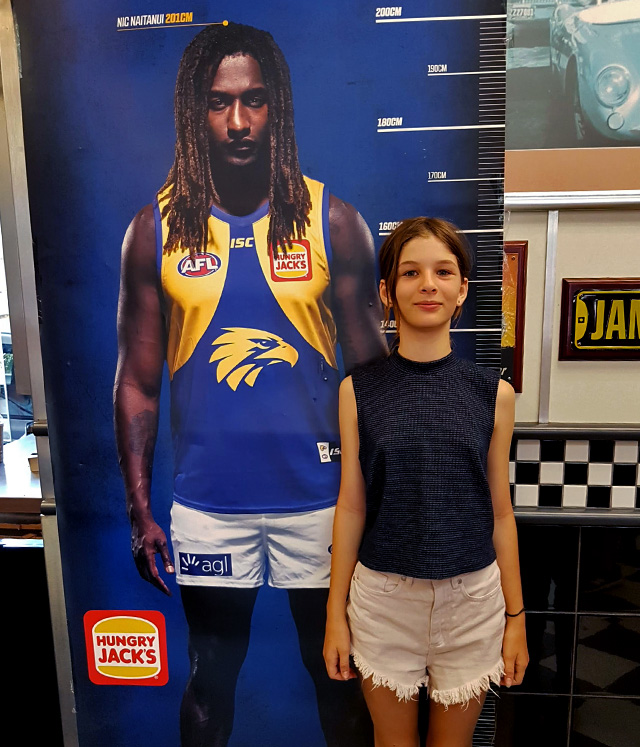While successful AFL players can come in all shapes and sizes, certain physical attributes, such as height, hand span, arm length, body mass & skinfolds, can all play an important part in performance. For example, being tall gives a distinct advantage for reaching the ball, body shape can affect balance, and carrying excess body fat increases fatigue.
In our poll about the component of fitness most important for success in AFL, body size and composition was rated one of the lowest, though it was above flexibility and strength. In a similar online survey, when we asked for your rating of 'Which Factors Make Successful AFL Players?', body size and composition was again rated one of the lowest, but greater than flexibility. Despite the low importance, the impact player body size, shape and composition can not be ignored.
Height
Tall players are at an advantage on the footy field, though there are many successful AFL players that are not tall. The list of tallest AFL footballers ever is made up of mostly ruckmen, clearly demonstrating that height is an advantage for this playing position. Taller players, combined with a good leap and positional skills, will win the ruck more often. Around the field, height is an advantage in overhead marking contests, and for reaching in for the ball, though tall players will find it harder to access ground balls.
Being short can also have an advantage, the lower center of gravity of shorter players may result in better balance and agility, a clear advantage while going for the loose balls. See the list of the shortest AFL players ever, despite small stature, these players have had a successful AFL career.
Girths and Widths
The width of the hand outstretched may be related to the ability to grab opposition players and mark the ball. Longer arms may be an advantage for football players when taking a mark or tackling an opposition player.
 measuring up against Nic Nat
measuring up against Nic NatWeight / Body Composition
No matter what the height of the player is, any excess body fat would affect the player's ability to move freely around the field, and also increase fatigue during training and game play. A simple way to look at this is using BMI, which indicates the weight relative to the player's height.
Some Relevant References
- Haycraft, J., Kovalchik, S., Pyne, D. B., & Robertson, S. (2017). Physical characteristics of players within the Australian Football League participation pathways: a systematic review. Sports medicine - open, 3(1), 46.
- Burgess D, Naughton G, Hopkins W. Draft-camp predictors of subsequent career success in the Australian Football League. J Sci Med Sport. 2012
- Robertson S, Woods C, Gastin P. Predicting higher selection in elite junior Australian rules football: the influence of physical performance and anthropometric attributes. J Sci Med Sport. 2015
- Woods CTE, Raynor AJ, Bruce L, et al. Predicting playing status in junior Australian football using physical and anthropometric parameters. J Sci Med Sport. 2015
- Pyne DB, Gardner AS, Sheehan K, et al. Positional differences in fitness and anthropometric characteristics in Australian football. J Sci Med Sport. 2006
- Young WB, Newton RU, Doyle TLA, et al. Physiological and anthropometric characteristics of starters and non-starters and playing positions in elite Australian rules football: a case study. J Sci Med Sport. 2005
- Gaudion S, Kenji D, Sinclair W, et al. Identifying the physical fitness, anthropometric and athletic movement qualities discriminant of developmental level in elite junior Australian football: implications for the development of talent. J Strength Cond Res. 2017;
- Bilsborough JC, Greenway KG, Opar DA, et al. Comparison of anthropometry, upper-body strength, and lower-body power characteristics in different levels of Australian football players. J Strength Cond Res. 2015
- Woods CT, Cripps A, Hopper L, et al. A comparison of the physical and anthropometric qualities explanatory of talent in the elite junior Australian football development pathway. J Strength Cond Res. 2016
- Keogh J. The use of physical fitness scores and anthropometric data to predict selection in an elite under 18 Australian rules football team. J Sci Med Sport. 1999;2(2):125–133.
- Young WB, Pryor L. Relationship between pre-season anthropometric and fitness measures and indicators of playing performance in elite junior Australian rules football. J Sci Med Sport. 2007
- Dupler TL, Amonette WE, Coleman AE, et al. Anthropometric and performance differences among high-school football players. J Strength Cond Res. 2010
- Veale JP, Pearce AJ, Koehn S, et al. Performance and anthropometric characteristics of prospective elite junior Australian footballers: a case study in one junior team. J Sci Med Sport. 2008.
- Wood, R.J., Marsden, J.F. and Finn, J.P., Comparison of size and performance characteristics of indigenous and non-indigenous Australian Football League players at the Northern Territory Institute of Sport, Proceedings of the 2000 Pre-Olympic Congress: Sports medicine and Physical Education International Congress on Sport Science, 2000.
Related Pages
- Attributes of a Great AFL Player
- Sport Specific Anthropometry — about body size and composition of many sports
- Indigenous AFL players are shorter, lighter and faster
- A discussion of fitness components of AFL
- Fitness for AFL
- About the AFL draft camp, and results from previous years.
- Fitness components for AFL [poll]
- Which Factors Make Successful AFL Players? [poll]
- All about anthropometry testing


 Current Events
Current Events